| Site | Name of pyramid | Culture | Base length (m) | Height (m) | Inclination | Approximate time of construction | Function | Notes | Image |
|---|
| Altun HaBelize | | Maya | | 16 | | 200 to 900 CE | | |  |
| CaracolBelize | | Maya | | | | | | |  |
| LamanaiBelize | The High Temple | Maya | | | | Pre-Classic Period | | |  |
| LamanaiBelize | The Temple of the Jaguar | Maya | | | | Pre-Classic Period | | |  |
| LubaantunBelize | | Maya | | | | 730 to 890 CE | | Lubaantun's structures are mostly built of large stone blocks laid with no mortar, primarily black slate rather than the limestone typical of the region. |  |
| LubaantunBelize | | Maya | | | | 730 to 890 CE | | Lubaantun includes many small step pyramids as well as the larger one. | 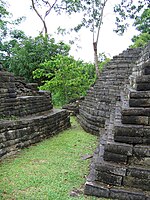 |
| Nim Li PunitBelize | | Maya | | tallest 12.2 | | 400 to 800 CE | | Nim Li Punit has several small step pyramids. | |
| XunantunichBelize | El Castillo | Maya | | 40 | | 600 to 900 CE | | |  |
| San Andrés, El Salvador | the Bell of San Andrés | Maya | | | | 600 to 900 CE | | This is a scale model of structure 5. There are several other smaller structures that may be similar to pyramids on the site. |  |
| Tazumal El Salvador | | Maya | | | | 250 to 900 CE | | |  |
| AguatecaGuatemala | | Maya | | 6 | | 760 to 830 CE | | This temple pyramid was left unfinished when the city was abandoned. |  |
| Dos PilasGuatemala | LD-49 | Maya | | 20 | | after 629 CE | | This pyramid's main stairway (known as Hieroglyphic Stairway 2) contains at least eighteen hieroglyphic steps. | |
| Dos PilasGuatemala | El Duende | Maya | | | | after 629 CE | | This temple pyramid was built by enlarging and terracing a natural hill some way from the site core, giving the impression of a single massive structure. | |
| KaminaljuyuGuatemala | | Maya | | | | 250 CE | | Kaminaljuyu contains some 200 platforms and pyramidal mounds at least half of which were made before 250 CE. Some of these were used to hold temples on top. | |
| El MiradorGuatemala | La Danta | Maya | | 72 | | 300 BCE to 100 CE | | La Danta pyramid temple has an estimated volume of 2,800,000 cubic meters which makes it one of the largest pyramids in the world. | |
| El MiradorGuatemala | El Tigre | Maya | | 55 | | 300 BCE to 100 CE | | | |
| Mixco ViejoGuatemala | | Maya | | | | 1100 to 1500 CE | | |  |
| TikalGuatemala | | Maya | | 47 | | | | |  |
| CopánHonduras | | Maya | | | | | | Copán has several overlapping step-pyramids. |  |
| BonampakMexico | The Temple of the Murals | Maya | | | | 580 to 800 CE | | |  |
| CalakmulMexico | The Great Pyramid | Maya | | 55 | | | | | |
| Chichen Itza Mexico | El Castillo | Maya | 55.3 | 30 | | | | |  |
| CholulaMexico | The Great Pyramid of Cholula | Xelhua | 450 sq. | 66 | | | | | 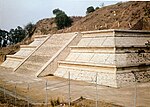 |
| CobaMexico | The Nohoch Mul pyramid | Coba | | 42 | | 500 to 900 CE | | |  |
| CobaMexico | La Iglesia | Coba | | | | 500 to 900 CE | | |  |
| CobaMexico | Crossroads Temple | Coba | | | | 500 to 900 CE | | |  |
| El TajínMexico | Pyramid of the Niches | Classic Veracruz | | 18 | | | | | 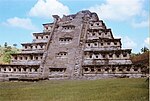 |
| La VentaMexico | The Great Pyramid | Olmec | | 33 | | | | This is one of the earliest pyramids known in Mesoamerica. It was made out of an estimated 100,000 cubic meters of earth fill. The current conical shape of the pyramid was once thought to represent nearby volcanoes or mountains, but recent work by Rebecca Gonzalez-Lauck has shown that the pyramid was in fact a rectangular pyramid with stepped sides and inset corners. | |
| PalenqueMexico | Temple of the Cross | Maya | | | | | | |  |
| PalenqueMexico | Temple of the Inscriptions | Maya | | | | | | |  |
| Santa Cecilia AcatitlanMexico | | Aztec | | | | | | In 1962, the architect and archaeologist Eduardo Pareyon Moreno reconstructed and reinforced the pyramid's basement and rebuilt the temple that crowns it. | 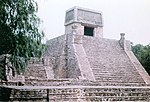 |
| TenayucaMexico | | Aztec | 62 by 50 | | | | | This is the earliest example yet found of the typical Aztec double pyramid, which consists of joined pyramidal bases supporting two temples. |  |
| TenochtitlanMexico | Templo Mayor | Aztec | 100 by 80 | | | 1390 to 1500 CE | | Tenochtitlan was destroyed by the Spanish. Recreations of this and other pyramids are based on historical text and archaeological ruins. |  |
| TenochtitlanMexico | | Aztec | | | | 1325 to 1521 CE | | Tenochtitlan was destroyed by the Spanish. Recreations the city are based on historical text and archaeological ruins. This site once included at least half a dozen pyramids. | 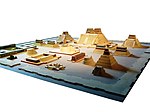 |
| TeotihuacanMexico | Pyramid of the Sun | Teotihuacano | 223.5 | 71.2 | 32.494 | | | There are also dozens of platforms 4 stories high lining the Avenue of the Dead atTeotihuacan. These each step in each story and they have a stair way to the top in front of the platforms. |  |
| TeotihuacanMexico | Pyramid of the Moon | Teotihuacano | | | | | | |  |
| El TepoztecoMexico | | Aztec | | | | 1502 CE | | |  |
| Tula, HidalgoMexico | | Toltec | | | | | | | 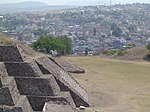 |
| UxmalMexico | Pyramid of the Magician | Maya | | | | | | | 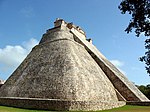 |
| UxmalMexico | La Gran Pyramide | Maya | | | | | | | 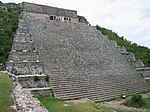 |
| XochicalcoMexico | Temple of the Feather Serpent | | | | | 200 BCE to 900 CE | | | 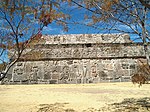 |
| XochicalcoMexico | | | | | | 200 BCE to 900 CE | | This is one of several other step-pyramid temples in addition to the Temple of the Feather Serpent | 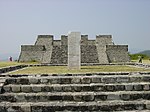 |
| XochitecatlMexico | The Pyramid of Flowers | | 100 by 140 | | | the Preclassic Period | | | |
| XochitecatlMexico | The Spiral Building | | | | | 700 BCE | | This is a circular stepped pyramid. The interior of the structure consists of volcanic ash. The building has no stairway giving access to the top, it was climbed by following the spiral form of the building itself. | |
| YaxchilanMexico | | Maya | | | | 600 to 900 CE | | This is one of the pyramids on the upper terrace of Yaxchilan |  |















































